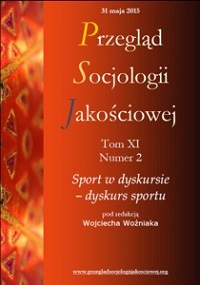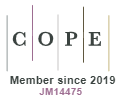Kiedy płeć nie ma znaczenia. Nie/normatywne ciała w dyskursie narodowym i sportowego sukcesu
DOI:
https://doi.org/10.18778/1733-8069.11.2.06Słowa kluczowe:
sport, płeć, narodowość, sukces, ciało nie/normatywneAbstrakt
Artykuł przedstawia, w jaki sposób postrzeganie nie/normatywnego ciała zmienia się, kiedy płeć krzyżuje się z kategorią narodowości i (braku) sukcesu. Podjęta jest dyskusja, w jaki sposób te dwa czynniki, narodowość i sukces, wpływają na: (1) wybory sportowej publiczności, (2) postrzeganie wyglądu zawodniczek, (3) postrzeganie sportu jako „kobiecego” versus „męskiego”. Artykuł opiera się na koncepcji intersekcjonalności i odwołuje do badań własnych zrealizowanych w latach 2012 i 2013 oraz analizy dyskursu wybranych przypadków.
Pobrania
Bibliografia
Billig Michael (2008) Banalny nacjonalizm. Przełożył Maciek Sekerdej. Kraków: Wydawnictwo Znak.
Google Scholar
Billings Andrew C. (2008) Olympic Media: Inside the Biggest Show on Television. London: Routledge.
Google Scholar
Billings Andrew C., Eastmann Susan T. (2002) Selective Representation of Gender, Ethnicity, and Nationality in American Television Coverage of the 2000 Summer Olympics. „International Review for the Sociology of Sport”, vol. 37, no. 3–4, s. 351–370.
Google Scholar
DOI: https://doi.org/10.1177/101269020203700302
Boutilier Mary A., SanGiovanni Lucinda (1983) The Sporting Woman. Champaign: Human Kinetics.
Google Scholar
Daddario Gina (1994) Chilly Scenes of the 1992 Winter Games: The Mass Media and the Marginalisation of Female Athletes. „Sociology of Sport Journal”, vol. 7, s. 275–288.
Google Scholar
DOI: https://doi.org/10.1123/SSJ.11.3.275
Delorme Nicolas (2014) Were Women Really Underrepresented in Media Coverage of Summer Olympic Games (1984-2008)? An Invitation to Open a Methodological Discussion Regarding Sex Equity in Sports Media. „Mass Communication and Society”, vol. 17, no. 1, s. 121–147.
Google Scholar
DOI: https://doi.org/10.1080/15205436.2013.816740
Duncan Margaret C., Messner Michael A., Willms Nicole (2005) Gender in Televised Sports: News and Highlights Shows, 1989–2004. Los Angeles: Amateur Athletic Foundation of Los Angeles.
Google Scholar
Eastman Susan T., Billings Andrew C. (1999) Gender Parity in the Olympics: Hyping Women Athletes, Favoring Men Athletes. „Journal of Sports and Social Issues”, vol. 23, no. 2, s. 140–170.
Google Scholar
DOI: https://doi.org/10.1177/0193723599232003
Eastman Susan T., Billings Andrew C. (2001) Biased Voices of Sports: Racial and Gender Stereotyping in College Basketball Announcing. „Howard Journal of Communication”, vol. 12, no. 4, s. 183–204.
Google Scholar
DOI: https://doi.org/10.1080/106461701753287714
Edensor Tim (2004) Tożsamość narodowa, kultura popularna i życie codzienne. Przełożyła Agata Sadza. Kraków: WUJ.
Google Scholar
Farrell Annemarie (2006) Why Women Don’t Watch Women’s Sport: A Qualitative Analysis. Niepublikowana rozprawa doktorska, Ohio State University.
Google Scholar
Fuller Lynda K. (ed.) (2006) Sport, Rhetoric, and Gender. Historical Perspectives and Media Representations. New York: Palgrave Macmillan.
Google Scholar
DOI: https://doi.org/10.1057/9780230600751
Hardin Marie, Hardin Brent (2004) The Supercrip in Sport Media: Wheelchair Athletes Discuss Hegemony Disabled Hero. „Sociology of Sport Online”, vol. 7, no. 1 [dostęp 28 października 2013 r.]. Dostępny w Internecie http://physed.otago.ac.nz/sosol/v7i1/v7i1_1.html
Google Scholar
Howe P. David (2011) Cyborg and Supercrip: The Paralympics Technology and the (Dis)Empowerment of Disabled Athletes. „Sociology”, vol. 45, no. 5, s. 868–882.
Google Scholar
DOI: https://doi.org/10.1177/0038038511413421
Jakubowska Honorata (2013) Płciowe porządki ‒ granice płci w sporcie według koncepcji Mary Douglas. „Człowiek i Społeczeństwo”, nr 36/1, s. 113‒128.
Google Scholar
Jakubowska Honorata (2014) Gra ciałem. Praktyki i dyskursy różnicowania płci w sporcie. Warszawa: Wydawnictwo Naukowe PWN.
Google Scholar
Koivula Nathalie (1995) Rating of Gender Appropriateness of Sports Participation: Effects of Gender-Based Schematic Processing. „Sex Roles”, vol. 33, s. 543–557.
Google Scholar
DOI: https://doi.org/10.1007/BF01544679
Koivula Nathalie (2001) Perceived Characteristics of Sports Categorized as Gender-Neutral, Feminine, and Masculine. „Journal of Sport Behavior”, vol. 24, no. 4, s. 377–393.
Google Scholar
Kristeva Julia (2007) Potęga obrzydzenia. Esej o wstręcie. Przełożył Maciej Falski. Kraków: Wydawnictwo UJ.
Google Scholar
Kvale Steinar (2004) InterViews. Wprowadzenie do jakościowego wywiadu badawczego. Przełożył Stanisław Zabielski. Białystok: Trans Humana.
Google Scholar
Larson James F., Riverburgh Nancy K. (1991) A Comparative Analysis of Australian, U.S., and British Telecasts of the Seoul Olympic Ceremony. „Journal of Broadcasting and Electronic Media”, vol. 35, s. 75–94.
Google Scholar
DOI: https://doi.org/10.1080/08838159109364103
Ličen Simon, Billings Andrew (2013) Cheering for ‘Our’ Champs by Watching ‘Sexy’ Female Throwers: Representation of Nationality and Gender in Slovenian 2008 Summer Olympic Television Coverage. „European Journal of Communication”, vol. 28, s. 379‒396.
Google Scholar
DOI: https://doi.org/10.1177/0267323113484438
von der Lippe Gerd (2002) Media Image. Sport, Gender, and National Identities in Five European Countries. „International Review for the Sociology of Sport”, vol. 37, no. 3–4, s. 371‒395.
Google Scholar
DOI: https://doi.org/10.1177/101269020203700306
Metheny Eleanor (1965) Connotations of Movement in Sport and Dance. Dubuque, IA: W.C. Brown.
Google Scholar
Messner Michael A., Cooky Cheryl (2010) Gender in Televised Sports. News and Highlights Shows, 1989–2009. Center for Feminist Research, University of Southern California [dostęp 18 października 2012 r.]. Dostępny w Internecie http://dornsife.usc.edu/cfr/gender-in-televised-sports
Google Scholar
Postow Betsy C. (1980) Women and Masculines Sports. „Journal of the Philosophy of Sport”, vol. 7, s. 51–58.
Google Scholar
DOI: https://doi.org/10.1080/00948705.1980.9714366
Real Michel R., Mechikoff Robert A. (1992) Deep Fan: Mythic Identification, Technology, and Advertising in Spectator Sports. „Sociology of Sport Journal”, vol. 9, s. 323–339.
Google Scholar
DOI: https://doi.org/10.1123/ssj.9.4.323
Silva Carla F., Howe P. David (2012) The (In)Validity of Supercrip Representation of Paralympian Athletes. „Journal of Sport and Social Issues”, vol. 36, no. 2, s. 174–194.
Google Scholar
DOI: https://doi.org/10.1177/0193723511433865
Vincent John i in. (2007) Analysing the Print Media Coverage of Professional Tennis Players: British Newspaper Narratives About Female Competitors in the Wimbledon Championships. „International Journal of Sport Management and Marketing”, vol. 2, s. 281‒300.
Google Scholar
DOI: https://doi.org/10.1504/IJSMM.2007.012406
Whiteside Erin, Hardin Marie (2011) Women (Not) Watching Women: Leisure Time, Television, and Implications for Televised Coverage of Women’s Sports. „Communication, Culture & Critique”, vol. 4, no. 2, s. 122–143.
Google Scholar
DOI: https://doi.org/10.1111/j.1753-9137.2011.01098.x
Pobrania
Opublikowane
Jak cytować
Numer
Dział
Licencja

Utwór dostępny jest na licencji Creative Commons Uznanie autorstwa – Użycie niekomercyjne – Bez utworów zależnych 4.0 Międzynarodowe.














